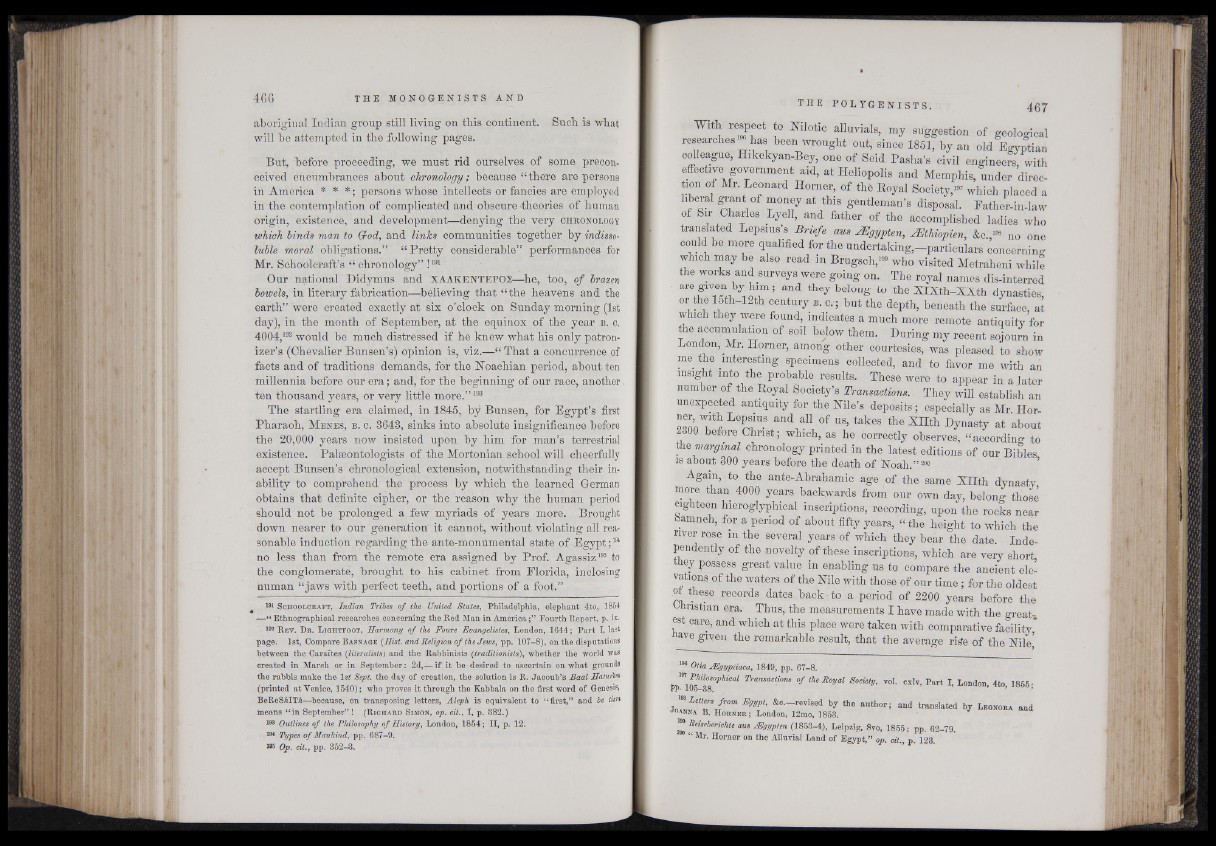
aboriginal Indian group still living on this continent. Such is what
will he attempted in the following pages.
But, before proceeding, we must rid ourselves of some preconceived
encumbrances about chronology; because “ there are persons
in America * * *; persons whose intellects or fancies are employed
in the contemplation of complicated and obscure -theories of human
origin, existence, and development— denying the very chronology
which hinds man to God, and links communities together by indissoluble
moral obligations.” “ Pretty considerable” performances for
Mr. Schoolcraft’s “ chronology” !191
Our national Didymus and XAAKENTEPOE— he, too, of brazen
bowels, in literary fabrication—believing that “ the heavens and the
earth” were created exactly at six o’clock on Sunday morning (1st
day), in the month of September, at the equinox of the year b . c .
4004,192 would be much distressed if he knew ivhat his only patron-
izer’s (Chevalier Bunsen’s) opinion is, viz.—“ That a concurrence of
facts and of traditions demands, for theNoachian period, about ten
millennia before our era; and, for the beginning of our race, another
ten thousand years, or very little more.” 193
The startling era claimed, in 1845, by Bunsen, for Egypt’s first
Pharaoh, M e n e s , b . c. 3643, sinks into absolute insignificance before
the 20,000 years now insisted upon by him for man’s terrestrial
existence. Palaeontologists of the Mortonian school will cheerfully
accept Bunsen’s chronological extension, notwithstanding their inability
to comprehend the process by which the learned German
obtains that definite cipher, or the reason why the human period
should not be prolonged a few myriads of years more. Brought
down nearer to our generation it cannot, without violating all reasonable
induction regarding the ante-monumental state of Egypt;191
no less than from the remote era assigned by Prof. Agassiz195 to
the conglomerate, brought to his cabinet from Florida, inclosing
numan “jaws with perfect teeth, and portions of a foot.”
191 S c h o o l c r a f t , Indian Tribes of the United States, Philadelphia, elephant 4to, 1864
—“ Ethnographical researches concerning the Red Man in Am ericaF our th Report, p. ix.
192 R e v . D r . L ig h t f o o t , Harmony of the Foure Evangelistes, London, 1644; Part I, last
page. 1st, Compare B a s n a g e {Hist, and Religion of the Jews, pp. 107-8), on the disputations
between the Carai'tes [lileralists) and the Rabbinists (traditionists), whether the world was
created in March or in September: 2d,— if it be desired to ascertain on what grounds
the rabbis make the ls i Sept. the day of creation, the solution is R. Jacoub’s Baal Haturbn
(printed at Venice, 1540); who proves it through the Kabbala on the first word of Genesis,
BeReSAITA—because, on transposing letters, Aleph is equivalent to “ first,” and be tier*
means “ in September” ! ( R i c h a r d S im o n , op. cit., I, p. 882.)
193 Outlines of the Philosophy of History, London, 1854; II, p. 12.
194 Types of Mankind, pp. 687—9.
195 Op. cit., pp. 352-8.
With respect to Nilotic alluvials, my suggestion of geological
researches has been wrought out, since 1851, by an old Egyptian
colleague, Hikekyan-Bey, one of Seid Pasha’s civil engineers, with
effective government aid, at Heliopolis and Memphis, under direction
of Mr Leonard Horner, of the Royal Society,192 which placed a
liberal grant of money.at this gentleman’s disposal. Eather-in-law
of Sir Charles Lyell, and father of the accomplished ladies who
translated Lepsius s Briefe aus JEgypten, JEthiopien, &e.,19S no one
could be more qualified for the undertaking,—particulars concerning
which may be also read in Brugsch,199 who visited Metraheni while
the works and surveys were going on. The royal names dis-interred
and the^ belong to the XlXth-XXth dynasties,
i l l B p V B E S B’ I but the dePth> beneath the surface, at
which they were found, indicates a much more remote antiquity for
the accumulation of soil below them. During my recent sojourn in
London, Mr. Horner, among other courtesies, was pleased to show
me the interesting specimens collected, and to favor me with an
insight into the probable results. These were to appear in a later
number of the Royal Society’s Transactions. They will establish an
unexpected antiquity for the Nile’s deposits; especially as Mr Hor Bill HSI andiaU °f US) takes tbe Nllth Dynasty at about
2300 before Christ; which, as he correctly observes, “ according to
the marginal chronology printed in the latest editions of our Bibles
is about 300 years before the death of Noah.” 200
Again, to the ante-Abrahamic age of the same XHth dynasty
more than 4000 years backwards from our own day, belong those
eighteen hieroglyphical inscriptions, recording, upon the rocks near
feamneh, for a period of about fifty years, “ the height to which the
river rose m the several years of which they bear the date. Independently
of the novelty ofthese inscriptions, which are veiy short,
they possess great value in enabling us tq compare the ancient elevations
of the waters of the Nile with those of our time; for the oldest
ol these records dates back-to a period of 2200 years before the
ristian era' Tbus, the measurements I have made with the great-,
est care, and which at this place were taken with comparative facility*
Have giyen the remarkable result, that the average rite of the Nile’
196 Otia JEgypliaca, 1849, pp. 67-8.
¡ ¡ ■ H » Tramaeti01w of the Royal Society, vol. cxlv, Part I, London, 4to, 1855-
pp. luo—38.
E m t ' &0- - rOTised ^ the anther; and translated by Leohora and
^ o anna B. H o r n e r ; London, 12mo, 1853.
® Reiseberichte aus /Egypten (18-53-4), Leipzig. 8vo, 1855; pp. 62-79.
Mr. Horner on the Alluvial Land of Egypt,” op. cit., p. 123.